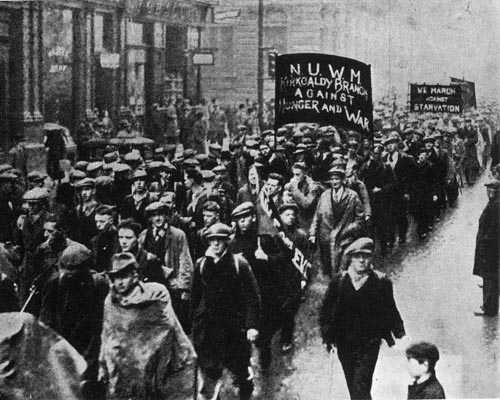The main capitalist political parties all agree that there must be massive cuts in public spending.Their common demand in 2010 echoes unmistakably what happened in the public spending debt crises of 1921 and 1931…
The same old refrain: attack the working class
WORKERS, JULY 2010 ISSUE
Working class families suffered terrible hardship and suffering during the 1920s and 1930s, and especially now we must examine this part of our past to see what happened last time the political parties imposed such policies. Otherwise we will be condemned to repeat history endlessly.
The Geddes Axe 1921
During and after the First World War, government expenditure in Britain rocketed and the national debt rose rapidly. Also, 1920 had seen a prodigious boom and speculative mania. However, boom quickly turned to slump and the banks were left holding debts that could not be repaid. Unemployment soared and fluctuated in 1921 between 1,664,000 and over 2,500,000.
The owner of the Daily Mail, Lord Rothermere, created the Anti-Waste League which between February and June 1921 started winning by-elections on a manifesto of attacking ‘excessive’ public spending.
Whereas in 1913–14 the Civil Services and Revenue Departments cost £81.3 million, by 1920-21 they cost £523.3 million, and in 1921–22, £590.7 million. Before the war, the Armed Forces cost around £77 million but approached
£190 million in 1921–22. The National Debt and other Consolidated Fund Services had increased dramatically over the same time too.

|
| 1934: one of the marches organised by the National Unemployed Workers Movement. |
In August 1921, the Liberal Prime Minister, Lloyd George, appointed a businessman, Sir Eric Geddes, as head of the Committee on National Expenditure to find where “economies” could be found in various government departments for 1922–23. His Committee recommended a severe retrenchment in government expenditure, which advocated cutbacks totalling £87 million and became known as the “Geddes Axe”. Total defence expenditure fell from £189.5 million in 1921–22 to £111 million in 1922–23; total social spending (education, health, housing, pensions, unemployment) fell from £205.8 million in 1920–21 to £182.1 million in 1922–23.
Most controversial were the cuts in social services. Lloyd George had promised the First World War soldiers “a land fit for heroes” but then cut back on those promises. The blade of Geddes Axe fell primarily on education and social housing. More workers became unemployed and there was a general attack on wages. Unemployment benefits were reduced. Distress was widespread.
The May Commission 1931
The economy never recovered during the 1920s. Instead there was a further economic slump and depression from 1929. Unemployment rose to two and a half million. The cost of unemployment benefit rose from £12 million in 1928 to £125 million in 1931. There was a collapse of European banks and a balance of payments crisis. A loan was negotiated from international bankers who stipulated public expenditure cuts.
In February 1931 the Labour Chancellor, Snowden, set up a Committee on National Expenditure chaired by Sir George May and other industrialists, which reported at the end of July 1931. Its conclusions were decided on the say-so of the majority, the 4 Conservative and Liberal nominees. The report calculated that the deficit for 1932-3 would be £120 million. They recommended that the deficit be “cured” by retrenchment in public expenditure, arguing that such expenditure was “definitely restrictive of industrial enterprise and employment”. They argued for wage cuts for the police, teachers and sections of the armed forces. Most cutbacks were to be made in the social services and public schemes of work. The attitude was that all public expenditure was wasteful. The total cutbacks amounted to £96.5 million; the largest individual cutback was unemployment insurance; there was also additional taxation.
The Labour Cabinet appointed an economy committee. There was a run on the pound (surprise, surprise) to pressurise a decision. When a consensus could not be reached on cutting unemployment benefits, a National Coalition Government headed by Ramsay MacDonald was formed to enact the cutbacks, splitting the Labour Party.
Much can be learned from the experience of these two previous exercises in cutting public expenditure. Interestingly, just as now, then there was a massive degree of unity between the Liberal, Conservative and Labour parties on cutting public expenditure in the 1920s and 1930s.
There was wholesale cooperation and connivance with these political attacks on our class by finance capital and big business in a deliberate attempt to shift the balance of power and protect their profit-making regime. Informal or formal party coalitions against the interests of the people were the norm.
Again, just as now, the excuse was that there were to be only “economies” or “removal of waste” or other sickening weasel expressions, no acknowledgement that what was being imposed were actual cutbacks of jobs, skills and services essential to a working class and its quality of life.
Attack on public sector
Crucially, the public sector workers laid off (or whose pay was cut) spent less on goods and services, no longer paid taxes and claimed unemployment benefits, which in turn deepened the recession and actually worsened the public expenditure finances. If allowed to happen today, the same things will recur.
The British economy remained in the doldrums for two whole inter-war decades: unemployment remained at least at one million and was often more than double that for nigh on twenty years. Capitalism’s economic recipe was a disaster for British workers; but the bankers and industrialists who had caused the crises lived well.
In essence, the government attacks on public expenditure in 1921 and 1931 helped sustain a permanent slump with millions either out of work or on low pay, and those conditions only ended in 1939 with the emergence of a nationally state-directed economy in a world war: a chilling reflection on and indictment of the workings of capitalism.